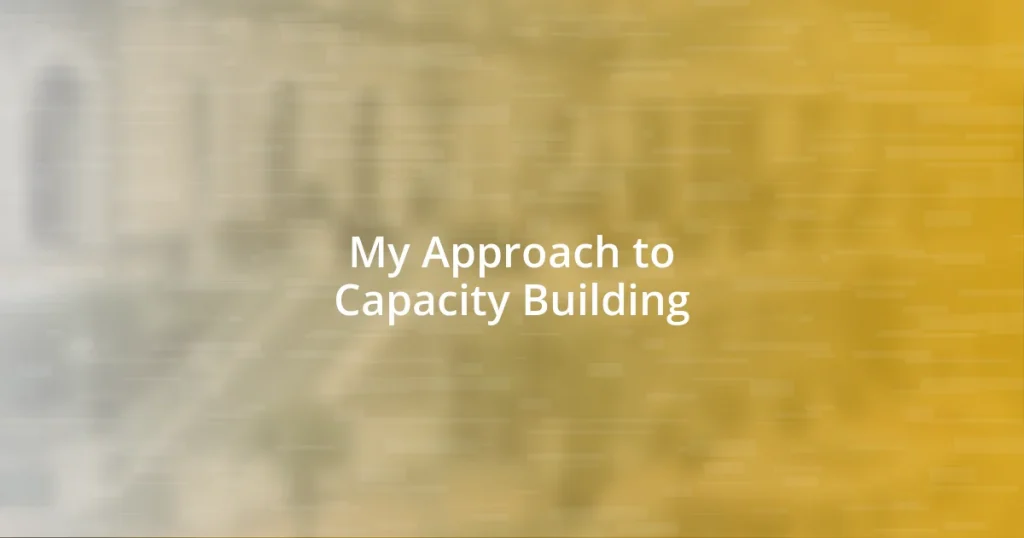Key takeaways:
- Capacity building empowers individuals and organizations by providing tailored strategies and fostering a mindset of growth, innovation, and resilience.
- Key components of effective capacity building include empowerment, collaboration, and sustainability, which enhance long-term growth and community impact.
- Challenges such as misalignment among stakeholders, resistance to change, and limited resources need to be navigated to ensure successful and sustainable capacity building efforts.

Understanding Capacity Building
Capacity building is all about empowering individuals and organizations with the skills and resources they need to thrive. I remember a time early in my career when I led a workshop for a local nonprofit. The excitement on participants’ faces as they learned new strategies painted a vivid picture of what capacity building can achieve. It’s not just about training; it’s about fostering a mindset of growth and resilience.
This process often involves a deep dive into the unique needs of a community or organization. From my experience, asking questions like “What challenges keep you up at night?” can reveal invaluable insights. When I engaged with a small business owner who felt overwhelmed by competition, we worked collaboratively to strengthen her marketing skills, and seeing her confidence blossom was incredibly rewarding.
Capacity building is not a one-size-fits-all approach. Each scenario is distinct, and that’s the beauty of it. I often think of capacity building as a garden—each project or initiative requires its own care and nurturing. What happens when we cultivate these diverse talents? I’ve seen it lead to innovation and resilience, proving that when we invest in people, the community flourishes as a whole.

Importance of Capacity Building
The importance of capacity building can’t be overstated. I remember attending a conference where a seasoned leader spoke about how investing in capacity building transformed her organization. The way she recounted her team’s journey from struggling to thriving made it evident that when individuals are equipped with the right skills and resources, they can drive meaningful change. This reinforces that capacity building isn’t just beneficial; it’s essential for sustainable growth.
- Empowerment: Equip individuals and organizations to take charge of their development.
- Adaptability: Foster resilience, allowing teams to navigate challenges with confidence.
- Collaboration: Build networks of support that enhance collective knowledge and capabilities.
- Sustainability: Create long-lasting impacts in communities through improved skills and resources.
- Innovation: Encourage creativity and new ideas by fostering an environment ripe for learning.
These elements are critical. Just reflecting on how a single training session I held for a local youth group led to some participants initiating community projects makes me believe deeply in capacity building’s transformative power. It’s truly remarkable to witness individuals step into their potential, inspired by newfound abilities and a sense of purpose.

Key Components of Capacity Building
Key Components of Capacity Building
Understanding the key components of capacity building is crucial for effective implementation. One core element is empowerment. I once organized a leadership retreat where participants created action plans tailored to their community goals. The energy in the room was electric as they visualized their aspirations and realized they had the power to bring those visions to life. It was a stark reminder that empowering individuals is the cornerstone of lasting change.
Another essential component is collaboration. During my work with various organizations, I’ve seen how strong networks can amplify efforts. In one instance, I connected different nonprofits to share resources for a community project. The resulting synergy was exceptional. By harnessing collective strengths, they achieved far more than they could have individually. That experience solidified my belief that collaboration elevates capacity building efforts significantly.
Lastly, there’s sustainability. It’s about creating systems and conditions that support continuous growth. I recall facilitating a workshop where we discussed integrating capacity building into everyday practices. Participants left with actionable steps, but what struck me most was their commitment to not just act once but to ensure that the lessons learned would benefit future leaders in their organizations. This focus on sustainability ensures that the impact of capacity building endures.
| Component | Description |
|---|---|
| Empowerment | Equipping individuals with the skills and confidence to initiate change. |
| Collaboration | Building relationships that enhance mutual support and resource sharing. |
| Sustainability | Creating long-term systems that support ongoing growth and learning. |

Strategies for Effective Capacity Building
To foster effective capacity building, one key strategy is tailored training programs that address specific needs. I recall a particular initiative where we surveyed participants before designing a workshop. This approach revealed unique skills gaps that we could focus on, ultimately leading to an engaging and impactful session. Isn’t it fascinating how a little customization can boost motivation and retention?
Another strategy revolves around mentorship and coaching. I’ve found that pairing less experienced individuals with seasoned professionals can create powerful learning experiences. For instance, during a community project, a mentor’s insights on navigating local regulations were invaluable. It dawned on me how this relationship not only enhanced knowledge transfer but also built lasting connections that extended beyond the project itself.
Lastly, promoting a culture of continuous feedback is essential. Implementing regular check-ins allows for real-time adjustments and encourages open communication. I remember conducting monthly feedback sessions in a program I managed, where participants openly shared successes and challenges. This transparency not only strengthened the group dynamic but also cultivated a sense of ownership over the learning process. How could we improve without recognizing our progress and setbacks?

Measuring Capacity Building Success
Measuring the success of capacity building is multifaceted, focusing not just on outcomes but also on the journey. I recall a project where we set clear, measurable goals and collected feedback throughout the process. By monitoring progress through surveys and discussions, we uncovered valuable insights that informed our approach and ultimately led to a stronger impact than we initially envisioned. This reflective process made it clear to me that success is not only about reaching a destination but also about learning along the way.
One powerful indicator of success is the degree of participant engagement. In a workshop I facilitated, I noticed that the participants’ enthusiasm peaked when they began sharing their own experiences. Their stories not only enriched the learning environment but also demonstrated a profound sense of investment in the material being covered. How often do we underestimate the power of personal connection in measuring success? This atmosphere of sharing reinforced my belief that genuine engagement can signal a strong foundation for sustainable capacity building.
Tracking the application of new skills is another vital measurement I’ve found effective. In one instance, after a training program, participants were encouraged to implement what they learned in their respective organizations. The follow-up conversations revealed how some had taken bold steps to innovate processes or collaborate with others. It reminded me that seeing real-world applications of training is a tangible sign of success. Yet, I often wonder: if we don’t verify these applications, how can we truly claim that genuine growth has occurred? This ongoing dialogue is essential to ensure the capacity-building efforts translate into lasting change.

Challenges in Capacity Building
The landscape of capacity building is often riddled with challenges that can feel overwhelming. One major obstacle I’ve encountered is the lack of alignment between stakeholders. In one of the community projects I was part of, differing expectations from various partners led to confusion. When interests aren’t harmonized, it becomes difficult to cultivate a cohesive approach. Have you ever found yourself caught in a similar situation, where everyone just seems to want different outcomes?
Another challenge is the resistance to change that can emerge in established organizations. I remember working with a team that had been following the same processes for years. When we introduced new methods, there was palpable hesitation. People were afraid to step out of their comfort zones, which is completely understandable. It makes me wonder, how do we inspire a willingness to embrace change when comfort often feels safer?
Lastly, limited resources, both financial and human, can significantly hamper capacity-building efforts. I once had a promising initiative fall short due to budget constraints, forcing us to cut corners on essential components, like training materials. It felt disheartening to compromise on quality when I knew the potential impact could have been much greater. What can we do to creatively manage resources so that they don’t limit our vision?

Sustaining Capacity Building Efforts
Sustaining capacity building efforts is about maintaining momentum, even after the initial enthusiasm fades. I vividly recall a project where, six months post-training, we organized a follow-up session. Participants were encouraged to share their experiences implementing new strategies, and the excitement in the room was palpable. It was inspiring to witness not just individual growth, but the collective reinforcement of knowledge that occurred when everyone rallied around shared successes and challenges.
Another critical aspect is continual support and resources. I’ve often found that providing ongoing mentorship can make a world of difference. When I stepped in to guide participants through the implementation phases, I noticed that the ones who received this support tended to push their boundaries further. Isn’t it fascinating how a little extra encouragement can transform uncertainty into confidence? This creates a culture where learning becomes an ongoing journey, rather than a single event.
Finally, integrating feedback loops is essential for sustainability. In one of my initiatives, we established regular check-ins to assess progress and operationalize adjustments. This practice not only kept the lines of communication open but also fostered an environment where participants felt valued and heard. Have you ever wondered how often organizations miss out on these critical dialogues? Creating spaces for reflection ensures that capacity building evolves with the needs of the group, reinforcing the idea that we’re all in this together.















